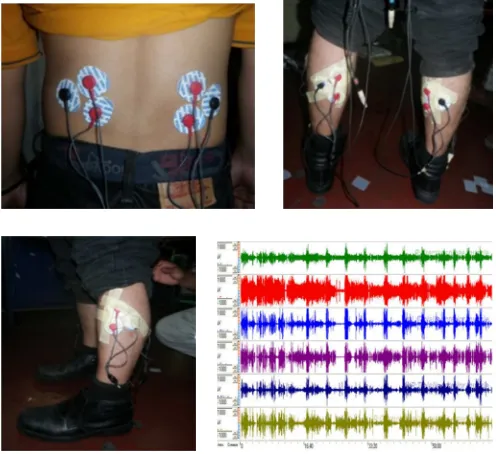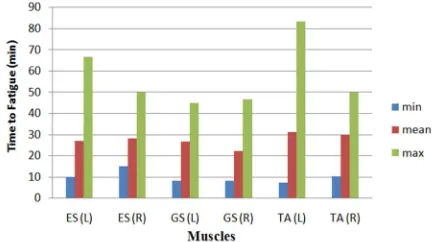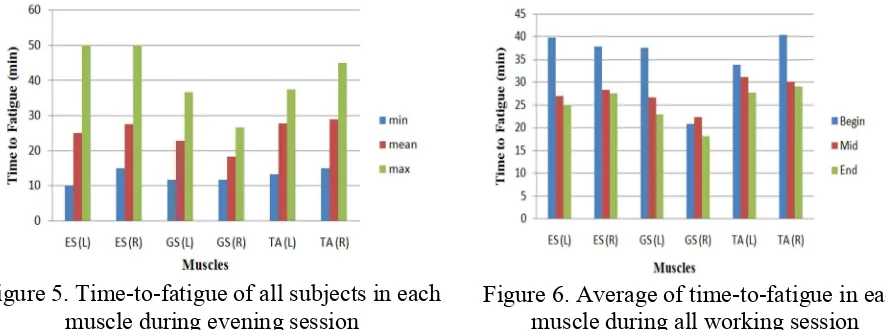! " ! ## ! $ %# &#' ' # ' () ** +
In metal stamping industry, almost all jobs are practically to be performed in standing position. Standing in a long period of time can lead to muscle fatigue. The objective of this study was to determine time-to-fatigue in the erector spinae, tibialis anterior, and gastrocnemius muscles of twenty production workers in a metal stamping company. The muscles activity was concurrently measured using surface electromyography (sEMG) during beginning, mid, and end of working sessions. Results of study found that gastrocnemius muscle fatigued earlier during all working sessions. In addition, working at the end of working session showed earlier fatigue than the beginning and mid of work days. The study concluded that standing in a long period of time is a cause to muscle fatigue experienced by the production workers.
In industrial workplaces, jobs can be performed either standing and/ or sitting position. Sitting position is commonly adopted when performing office works such as drafting, writing and computing tasks. Several jobs in the industry are recommended to be performed in standing position, as opposed to sitting. For examples, standing position is commonly practiced for manufacturing works such as welding, and machining process. Standing is preferred when the workstation does not allow the workers to comfortably position their legs under the working table. For instances, working on lathe machine or metal stamping machine is impossible to do in sitting because the design of those machines does not provide adequate space for the workers to position their legs.
Standing at industrial workplaces can be classified in two types; dynamic and stationary standing postures. Dynamic standing is a working position in which a worker intermittently walks while he or she is performing the jobs. On the other hand, stationary standing is a position in which a worker does not walk, but stands still while performing the tasks [1].
Standing working position has been linked to versatility because the position is easy for moving and having large degree of freedom. However, when the workers spent more than 50 percent of the total working hours in standing position, they are exposed to prolonged standing [1]. When workers are performing jobs in prolonged standing, static contraction occurred particularly in their back and legs, thus resulted to a diminished function of calf muscle [3]. Standing in prolonged period of time has been recognized as vital contributor to poor occupational health. This working position transfers the load of upper body to the lower parts and resulted to lower back pain. The American Podiatric Association reported that 83% of the United States industrial workers experienced foot or lower leg pain and discomfort associated from prolonged standing [4]. A hypothesized reason for the increased discomfort and whole body fatigue associated with prolonged standing conditions is reduced blood circulation in the lower legs and localized muscle fatigue [5].
The presence of fatigue in the group of muscles can be quantified through declines in maximum physical strength, changes in electromyography signals, and increases in subjective rating of discomfort [6]. In occupational ergonomics, the surface electromyography (sEMG) has been
prolonged standing exposures can be quantified by observing the changes in amplitude and frequency of electromyography signals over time [9]. When signal amplitude increases and power spectrum shifts to lower frequency, it indicates that the assessed muscles are in fatigue condition [6], [8], [10].
Time to fatigue can be explained as the time at which the change in the fatigue measure (electromyography data) had become significant degree [11]. It is expected that time to fatigue would decrease as duration of standing is increased. The square root of Mean Squared Error (√MSE) was used as a method to identify the variability in the median frequency (Hz). It is assumed that when the dependent measure median frequency (Hz) exceeded the √MSE value, this represented the time in the job cycle give significant chance for muscle fatigue.
The objective of this study was to determine time-to-fatigue in the left and right erector spinae muscles (lower back), left and right tibialis anterior muscles (anterior legs), and left and right gastrocnemius muscles (posterior legs) among production workers who performed their jobs in standing position.
A case study was conducted in a metal stamping company situated in Shah Alam, Malaysia. The main activities of the company are metal stamping process, die maintenance, and products restoration. In the production department, the company has two sections namely stamping process lines and handwork section. The stamping process lines produce metal stamped parts for vehicle assembly, and the handwork section performs restoration on the products of metal stamping process lines.
At the end of a metal stamping process line, a worker is assigned to collect the stamped parts from an incoming conveyor and arrange them in a cage. To complete the job, the worker is required to stand in awkward working postures such as: 1) 20º to 40º torso flexion while reaching the products from the incoming conveyor, 2) ~180º body rotation to transfer the products to a cage, 3) 20º to 30º torso flexion while attempting to load the products into the cage, 4) about 90º torso flexion to arrange the products in the cage (Figure 1). The worker has to perform the job manually with job cycle more than four times per minute. Furthermore, workers at metal stamping process line are exposed to whole body vibration due to high cyclic impact between plunger of stamping machine and its die.
Figure 1. Workers arrange the metal stamped parts in standing position and awkward working posture
Ten production workers from each department were recruited as subjects in the study. Only those working in prolonged standing and no injuries and disorders for the past 12 months were allowed to participate in the study [6]. All subjects were given a written consent, using procedures approved by the Research Ethics Committee of Universiti Teknologi MARA. The criteria of the selected workers are as follows:
Gender: all male.
Age (mean = 25.0 years, SD = 4.6 years). Body mass (mean = 58.4 kg, SD = 11.6 kg). Body height (mean = 1.67 m, SD = 0.08 m).
Work experience (mean = 5.2 years, SD = 4.6 years).
The sEMG ME3000P4 (MEGA Electronics, Finland) and MegaWin Software were used to record, store and analyze all the data regarding to muscles activity of the subjects. The sEMG system is equipped with electrodes to detect the electromyography signals of a subject while he is performing jobs. The electrodes were attached conscientiously to subject’s skin to measure electromyography signals in the six muscles: left and right erector spinae, left and right tibialis anterior, and left and right gastrocnemius. Figure 2 shows the placement of sEMG electrodes to detect electromyography signals in the selected muscles.
Figure 2. Surface electrodes are attached over the erector spinae muscles (top left), gastrocnemius muscles (top right) and tibialis anterior muscles (bottom left) to detect electromyography signals
(bottom right)
All muscles were concurrently measured more than five hours of standing to obtain muscle fatigue in the lower extremities of subjects. To determine the effects of prolonged standing in the muscles at different working periods, the sEMG measurements were conducted at the beginning of work day (9 a.m to 10.15 a.m), mid of work day (10.30 a.m to 12.30 p.m), and end of work day (2.00 p.m. to 4.30 p.m.) of three consecutive workdays; Monday to Wednesday. To ensure the sEMG protocols were complied especially the electrodes are attached properly to the respective muscles, a physiotherapist was consulted before the measurement is carried out. Setting of sEMG system during the measurement is based on Surface EMG for the Non-Invasive Assessment of Muscles (SENIAM) [12]. The settings are as follows:
EMG electrodes: Surface electrode Ag/AgCl, 20 mm diameter. Distance between electrodes: 25 mm.
Filter: Band pass filter (85 Hz – 500Hz). Sampling rate: 1000 Hz.
The measurements of muscles activity were conducted based on real time monitoring. All electrodes were connected to a data logger and the electromyography signals from the data logger are monitored through the lap top screen using wireless networking. Before the muscles activity measurement being started, the personal details of subject are recorded in the MegaWin Software. At the beginning of the measurement, the subject was given sufficient time to get enough practice and familiarize with the sEMG system. The subject was informed that he has to perform the jobs with his own control and should immediately report any feeling of pain or discomfort so that the sEMG measurement can be terminated. After all the measurement setting is ready, the subject was asked to perform his regular jobs.
! "
The overall measurement duration across all subjects during beginning of workday (first session) was 75 minutes, while the duration during the mid of workday (second session) was 120 minutes, and the third session (end of work day) was 150 minutes. During the first session, the right gastrocnemius muscle appeared to fatigue first (after 20 minutes in average), while the left tibialis anterior muscle, left gastrocnemius muscle, both left and right erector spinae muscles as well as right tibialis anterior muscle fatigue shortly thereafter (Figure 3). Similarly, the right gastrocnemius muscle showed fatigue slightly earlier among others at the second and third working sessions. Averagely, the right gastrocnemius muscle was found to fatigue earlier as compared to other muscles at all working sessions, as outlined in Figure 4 through Figure 5. The findings have shown an agreement with other study, whereby, the gastrocnemius muscle has been found to be fatigue significantly among female workers during performing standing jobs in electronics industry [13].
Meanwhile, other muscles have shown inconsistency in terms of time-to-fatigue. In general, each worker experienced muscle fatigue after standing more than 2 hours, especially at the end of work day (2.00 p.m. to 4.30 p.m.). In the figures, ES (L): left erector spinae; ES (R): right erector spinae; GS (L): left gastrocnemius; GS (R): right gastrocnemius; TA (L): left tibialis anterior; and TA (R): right tibialis anterior.
Figure 3. Time-to-fatigue of all subjects in each muscle during morning session
Figure 5. Time-to-fatigue of all subjects in each
muscle during evening session Figure 6. Average of time-to-fatigue in each muscle during all working session ! " # $ !
All working sessions were analyzed to identify which session lead to fatigue first. The beginning of work day appeared to be later fatigue for all muscles, except the right gastrocnemius muscle. In contrast, the end of work day showed slightly earlier fatigue than the mid of work day (Figure 6).
! " # $
Further analysis found that workers who perform jobs at metal stamping process lines seemed to fatigue later than those at handwork section during beginning of work day, whereby the right gastrocnemius muscle was identified to fatigue first (Figure 7). However, the metal stamping process lines appeared to fatigue earlier for both mid and end of workdays. Similarly, the right gastrocnemius muscle was found to fatigue first among others, as presented in Figure 8 through Figure 9.
Figure 7. Average of time-to-fatigue between metal stamping lines and handwork section
during morning session
Figure 8. Average of time-to-fatigue between metal stamping lines and handwork section
during afternoon session
Figure 9. Average of time-to-fatigue between metal stamping lines and handwork section during evening session
tail (1.833) or t Critical two-tail (2.262). Similarly, the t-test found that there is no significant different between working at metal stamping process lines and handwork section during mid of work day, as proved by t stat (-2.482) < t Critical one-tail (1.833) or t Critical two-tail (2.262). The end of work day also did not show any significant different in terms of time to fatigue in the right gastrocnemius muscle, as verified by t stat (-2.140) < t Critical one-tail (1.833) or t Critical two-tail (2.262). In other words, either working at metal stamping process lines or handwork section, the right gastrocnemius muscle appeared to fatigue first during all working sessions.
" !
Twenty male production workers have been participated in the study, ten of them worked at metal stamping process lines and another ten performed their jobs at handwork section. Obviously, all workers exposed to standing in long period of time because they required frequent movements and large degree of freedom to perform the jobs. For example, workers at metal stamping process lines need to reach the workpieces from pallet and feed to stamping machine corresponding to machine speed, thus the job was practicable to do in standing. In addition, the stamping machine provided insufficient clearance between workers’ legs and machine platform; hence the machine design does not allow workers to do stamping process in sitting. The space of working area was also restricted. The workers have to perform metal stamping process that is repetitive in nature throughout their working hours.
Handwork section on the other hand is a work department which required workers to do repair and restoration works on products produced by metal stamping process. Major activities at handwork section were grinding and knocking processes using conventional methods. Similar to metal stamping process lines, all workers at handwork section performed the jobs in standing position because they required large degree of freedom especially when performing grinding process on large products.
!! % !
Alternative solutions should be proposed and implemented to the workstation to minimize risk of muscle fatigue associated with prolonged standing jobs. In ergonomics discipline, engineering controls and administrative controls were found to be effective methods to reduce the risk of occupational injuries in industrial workplaces [14]. Engineering controls refer to the use of engineering techniques to minimize the risk of occupational injuries such as application of anti-fatigue mats, ergonomic footwear design, and soft work surface to release muscle anti-fatigue in the feet due to floor condition at the workplace.
Anti-fatigue floor mats and shoe in-soles have been identified as effective solutions to improve body comfort and occupational health during prolonged standing tasks. For example, King (2002) found that the floor mat, shoe in-soles and combined conditions were more comfortable than standing on hard floor [15]. Soft work surface has also shows a great potential to alleviate occupational injuries associated with prolonged standing exposures. Previous study has shown that the low mean power frequency (MPF) of EMG and decrement of calf surface temperature were observed when the subjects were standing on the soft work surface [5].
Work-rest scheduling is one of common approaches adopted through administrative methods to minimize the risk of muscle fatigue associated with prolonged standing. A study proved that providing longer breaks would seem more effective to minimize risk of leg swelling associated with prolonged standing [16]. Alternating standing and seated working position during working hours is also recommended to minimize muscle fatigue in the lower extremities [17-18].
The study has performed analysis on time-to-fatigue in the erector spinae, tibialis anterior, and gastrocnemius muscles of workers who performed jobs in standing position in a metal stamping company. Based on sEMG measurement, the study concluded that:
right gastrocnemius muscle fatigued earlier as compared to other muscles at all working sessions,
all muscles slightly earlier fatigue at the end of working session than the beginning and mid of working hours, and
muscle fatigue occur due to standing in a long period of time, regardless the nature of jobs. $ & !
The authors would like to acknowledge the Ministry of Higher Education of Malaysia, the Universiti Teknikal Malaysia Melaka, the Ministry of Science, Technology and Innovation (MOSTI) of Malaysia for funding this research under e-Science Research Grant, the Faculty of Mechanical Engineering of Universiti Teknologi MARA and Research Management Institute (RMI) of Universiti Teknologi MARA for providing facilities and assistance in conducting this study. Special thank also goes to Miyazu (M) Sdn. Bhd. for the permission and opportunity to facilitate a fruitful case study.
"
[1] V. Balasubramanian, K. Adalarasu, and R. Regulapati, "Comparing dynamic and stationary standing
postures in an assembly task," vol. 39, pp. 649-654, 2009.
[2] F. Tomei, T. P. Baccolo, E. Tomao, S.s Palmi, and M. V. Rosati, "Chronic venous disorders and
occupation," vol. 36, pp. 653-665, 1999.
[3] R. M. A. Krijnen, E. M. d. Boer, H. J. Ader, and D. P. Bruynzeel, "Diurnal volume changes of the lower legs
in healthy males with a profession that requires standing," vol. 4, pp. 18-23,
1998.
[4] J. E. Zander, P. M. King, and B. N. Ezenwa, "Influence of flooring conditions on lower leg volume
following prolonged standing," vol. 34, pp. 279-288, 2004.
[5] P. Madeleine, M. Voigt, and L. Arendt-Nielsen, "Subjective, physiological and biomechanical responses to prolonged manual work performed standing on hard and soft surfaces,"
vol. 77, pp. 1-9, 1998.
[6] Yassierli, "Muscle fatigue during isometric and dynamic efforts in shoulder abduction and torso extension: age effects and alternative electromyographic measures." PhD: the Virginia Polytechnic Institute and State University, 2005.
[7] S. Kumar, T. Amell, Y. Narayan, and N. Prasad, "Measurement of localized muscle fatigue in biceps brachii using objective and subjective measures," in , S. Kumar, Ed. New York: CRC Press, 2004, pp. 105-121.
[8] A. Luttmann, M. Jager, and W. Laurig, "Electromyographical indication of muscular fatigue in occupational
field studies," vol. 25, pp. 645-660, 2000.
[9] H. H. H.-v. Reenen, B. Visser, A. J. v. d. Beek, B. M. Blatter, J. H. v. Dieen, and W. v. Mechelen, "The effect of a resistance-training program on muscle strength, physical workload, muscle fatigue and
musculoskeletal discomfort: An experiment," pp. 1-8, 2009.
[10] I. Hostens and H. Ramon, "Assessment of muscle fatigue in low level monotonous task performance during
car driving," vol. 15, pp. 266-274, 2005.
[11] K. L. Margaret, "Effects of tool weight on fatigue and performance during short cycle overhead work operations," MSc: the Virginia Polytechnic Institute and State University, 1999.
[12] B. Freriks and H. Hermens, "European Recommendation for Surface Electromyography, Result of SENIAM Project," Roessignh Research and Development, The Netherlands 2000.
[13] N. Ahmad, Z. Taha, and P. L. Eu, "Energetic requirement, muscle fatigue, and musculoskeletal risk of prolonged standing on female Malaysian operators in the electronic industries: influence of age,"
! vol. 1, pp. 47-58, 2006.
[14] C. D. Wickens, J. D. Lee, Y. Liu, and S. E. G. Becker, " # ,
Second Edition ed. New Jersey: Pearson Prentice Hall, 2004.
[15] P. M. King, "A comparison of the effects of floor mats and shoe in-soles on standing fatigue," vol. 33, pp. 477-484, 2002.
[16] J. H. V. Dieen and H. H. E. O. Vrielink, "Evaluation of work-rest schedules with respect to the effects of postural workload in standing work," vol. 41, pp. 1832-1844, 1998.
[17] L. Hansen, J. Winkel, and K. Jørgensen, "Significance of mat and shoe softness during prolonged work in upright position: based on measurements of low back muscle EMG, foot volume changes, discomfort and
ground force reactions," vol. 29, pp. 217-224, 1997.



